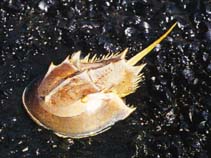Limulus polyphemus (Linnaeus, 1758)
Horseshoe crab| Native range | All suitable habitat | Point map | Year 2050 |

|
| This map was computer-generated and has not yet been reviewed. |
| Limulus polyphemus AquaMaps Data sources: GBIF OBIS |
Классификация / Names народные названия | синонимы | CoL | ITIS | WoRMS
Merostomata | Xiphosura | Limulidae
Environment: milieu / climate zone / пределы глубины / distribution range экология
; пределы глубины 3 - 11 m (ссылка 76). Tropical, preferred 24°C (ссылка 107945)
Distribution страны | регионы FAO | Ecosystems | места находок | интродукции
Western Atlantic: from Maine, USA to Mexico.
Length at first maturity / Size / Weight / Возраст
половая зрелость: Lm ? range ? - ? cm Max length : 60.0 cm TL самец/пол неопределен; (ссылка 82); наибольший вес (опубликованные данные): 1.8 kg (ссылка 82); наибольший возраст (опубликованны данные): 20 годы (ссылка 99652)
Life cycle and mating behavior половая зрелость | размножение | нерест | Eggs | Fecundity | Larvae
Основная ссылка
ссылки | координатор | соавторы
Lee, C.N. and B. Morton 2005 Experimentally derived estimates of growth by juvenile Tachypleus tridentatus and Carcinoscorpius rotundicauda (Xiphosura) from nursery beaches in Hongkong. Journal of Experimental Marine Biology and Ecology 318:39-49. (ссылка 1131)
Статус Красного Списка МСОП
(ссылка 130435: Version 2025-1)
Статус СИТЕС (ссылка 108899)
CMS (ссылка 116361)
Угроза для людей
Использование человеком
рыболовство: коммерческий
FAO - рыболовство: landings | FIRMS (Stock assessments) | FishSource | Sea Around Us
инструменты
дополнительная информация
ресурсы в Интернет
BHL | BOLD Systems | CISTI | DiscoverLife | FAO(рыболовство: ; publication : search) | Fishipedia | GenBank (Геном, Нуклеотид) | GloBI | Gomexsi | Google Books | Google Scholar | Google | PubMed | Tree of Life | Wikipedia (Вперёд, поиск) | Zoological Record



